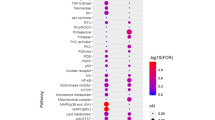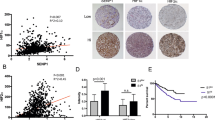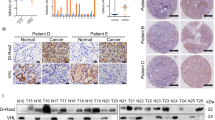Abstract
Incidence of kidney cancer is on the rise, and a better understanding of molecular mechanisms involved in the cancer invasion and metastasis is required for the development of curative therapeutics. In this study, we report that the proinflammatory cytokine prostaglandin E2 (PGE2) induces the malignant SN12C, but not benign HK2 kidney cell invasion. The PGE2 increases SN12C cell invasion through a signal pathway that encompasses EP2 and EP4, Akt, small GTPase RalA and Ral·GTP inactivator RGC2. The results support the idea that targeted interference of EP2/EP4 signal to RalA·GTP may provide benefit to patients diagnosed with advanced kidney cancer.
This is a preview of subscription content, access via your institution
Access options
Subscribe to this journal
Receive 50 print issues and online access
$259.00 per year
only $5.18 per issue
Buy this article
- Purchase on Springer Link
- Instant access to full article PDF
Prices may be subject to local taxes which are calculated during checkout






Similar content being viewed by others
References
Siegel R, Ward E, Brawley O, Jemal A . The impact of eliminating socioeconomic and racial disparities on premature cancer deaths. CA Cancer J Clin 2011; 61: 212–236.
Young AN, Dale J, Yin-Goen QQ, Harris WB, Petros JA, Datta MW et al. Current trends in molecular classification of adult renal tumors. Urology 2006; 67: 873–880.
Sun M, Lughezzani G, Perrotte P, Karakiewicz PI . Treatment of metastatic renal cell carcinoma. Nat Rev Urol 2010; 7: 327–338.
Biswas S, Eisen T . Immunotherapeutic strategies in kidney cancer - when TKIs are not enough. Nat Rev Clin Oncol 2009; 6: 478–487.
Schlesinger-Raab A, Treiber U, Zaak D, Holzel D, Engel J . Metastatic renal cell carcinoma: Results of a population-based study with 25 years follow-up. Eur J Cancer 2008; 44: 2485–2495.
Murai M, Oya M . Renal cell carcinoma: Etiology, incidence and epidemiology. Curr Opin Urol 2004; 14: 229–233.
Balkwill F, Mantovani A . Cancer and inflammation: Implications for pharmacology and therapeutics. Clin Pharmacol Therap 2010; 87: 401–406.
Grivennikov SI, Greten FR, Karin M . Immunity, inflammation, and cancer. Cell 2010; 140: 883–899.
Eruslanov E, Daurkin I, Vieweg J, Daaka Y, Kusmartsev S . Aberrant PGE2 metabolism in bladder tumor microenvironment promotes immunosuppressive phenotype of tumor-infiltrating myeloid cells. Int Immunopharmacol 2011; 11: 848–855.
Hao CM, Breyer MD . Physiological regulation of prostaglandins in the kidney. Ann Rev Physiol 2008; 70: 357–377.
Wang DZ, Dubois RN . Eicosanoids and cancer. Nat Rev Cancer 2010; 10: 181–193.
Pugh S . Thomas GAO. Patients with adenomatous polyps and carcinomas have increased colonic mucosal prostaglandin E2. Gut 1994; 35: 675–678.
Asano T, Shoda J, Ueda T, Kawamoto T, Todoroki T, Shimonishi M et al. Expressions of cyclooxygenase-2 and prostaglandin E receptors in carcinoma of the gallbladder: Crucial role of arachidonate metabolism in tumor growth and progression. Clin Cancer Res 2002; 8: 1157–1167.
Sugimoto Y, Narumiya S . Prostaglandin E receptors. J Biol Chem 2007; 282: 11613–11617.
Buchanan FG, Wang DZ, Bargiacchi F, DuBois RN . Prostaglandin E2 regulates cell migration via the intracellular activation of the epidermal growth factor receptor. J Biol Chem 2003; 278: 35451–35457.
LopezIlasaca M, Crespo P, Pellici PG, Gutkind JS, Wetzker R . Linkage of G protein-coupled receptors to the MAPK signaling pathway through PI 3-kinase gamma. Science 1997; 275: 394–397.
Sheng HM, Shao JY, Washington MK, DuBois RN . Prostaglandin E2 increases growth and motility of colorectal carcinoma cells. J Biol Chem 2001; 276: 18075–18081.
Wang DZ, Wang HB, Brown J, Daikoku T, Ning W, Shi Q et al. CXCL1 induced by prostaglandin E2 promotes angiogenesis in colorectal cancer. J Exp Med 2006; 203: 941–951.
Salcedo R, Zhang X, Young HA, Michael N, Wasserman K, Ma WH et al. Angiogenic effects of prostaglandin E2 are mediated by up-regulation of CXCR4 on human microvascular endothelial cells. Blood 2003; 102: 1966–1977.
Chen XW, Leto D, Xiong TT, Yu GG, Cheng A, Decker S et al. A Ral GAP complex links PI 3-kinase/Akt signaling to RalA activation in insulin action. Mol Biol Cell 2011; 22: 141–152.
Castellone MD, Teramoto H, Williams BO, Druey KM, Gutkind JS . Prostaglandin E2 promotes colon cancer cell growth through a Gs-axin-beta-catenin signaling axis. Science 2005; 310: 1504–1510.
Kim WJ, Gersey Z, Daaka Y . Rap1GAP regulates renal cell carcinoma invasion. Cancer Lett 2012; 1820: 743–751.
Wu J, Zhang Y, Frilot N, Kim JI, Kim WJ, Daaka Y . Prostaglandin E2 regulates renal cell carcinoma invasion through the EP4 receptor-Rap GTPase signal transduction pathway. J Biol Chem 2011; 286: 33954–33962.
Lim KH, O'Hayer K, Adam SJ, Kendall SD, Campbell PM, Der CJ et al. Divergent roles for RalA and RalB in malignant growth of human pancreatic carcinoma cells. Curr Biol 2006; 16: 2385–2394.
Yin JJ, Pollock C, Tracy K, Chock M, Martin P, Oberst M et al. Activation of the RaIGEF/Ral pathway promotes prostate cancer metastasis to bone. Mol Cell Biol 2007; 27: 7538–7550.
Smith SC, Theodorescu D . The Ral GTPase pathway in metastatic bladder cancer: Key mediator and therapeutic target. Urol Oncol 2009; 27: 42–47.
Bodemann BO, White MA . Ral GTPases and cancer: Linchpin support of the tumorigenic platform. Nat Rev Cancer 2008; 8: 133–140.
Ikediobi ON, Davies H, Bignell G, Edkins S, Stevens C, O'Meara S et al. Mutation analysis of 24 known cancer genes in the NCI-60 cell line set. Mol Cancer Therap 2006; 5: 2606–2612.
Bukowski RM . Prognostic factors for survival in metastatic renal cell carcinoma update 2008. Cancer 2009; 115: 2273–2281.
Motzer RJ, Hutson TE, Tomczak P, Michaelson MD, Bukowski RM, Rixe O et al. Sunitinib versus interferon alfa in metastatic renal cell carcinoma. N Eng J Med 2007; 356: 115–124.
Halbrugge M, Walter U . Analysis, purification and properties of a 50000-dalton membrane-associated phosphoprotein from human platelets. J Chromatogr 1990; 521: 335–343.
Chijiwa T, Mishima A, Hagiwara M, Sano M, Hayashi K, Inoue T et al. Inhibition of forskolin-induced neurite outgrowth and protein-phosphorylation by a newly synthesized selective inhibitor of cyclic AMP-dependent protein-kinase, N-[2-(p-bromocinnamylamino)ethyl]-5-isoquinolinesulfonamide (H-89), of PC12d pheochromocytoma cells. J Biol Chem 1990; 265: 5267–5272.
Dillon RL, Muller WJ . Distinct biological roles for the Akt family in mammary tumor progression. Cancer Res 2010; 70: 4260–4264.
Luttrell LM, Daaka Y, Lefkowitz RJ . Regulation of tyrosine kinase cascades by G protein-coupled receptors. Curr Opin Cell Biol 1999; 11: 177–183.
Hattori M, Minato N . Rap1 GTPase: Function, regulation, and malignancy. J Biochem 2003; 134: 479–484.
DeWire SM . Violin JD. biased ligands for better cardiovascular drugs: Dissecting G protein-coupled receptor pharmacology. Circ Res 2011; 109: 205–216.
Acknowledgements
We thank Dr A Saltiel for providing anti-RGC2 and anti-phospho-RGC2 antibodies and the NCI for providing the SN12C cancer cells. We also thank Ms E Grigson and Ms K Durst for editorial assistance, and Dr Z Nie for reading and commenting on the manuscript. This work was supported, in part, by US National Institutes of Health grant R01 CA129155 (to YD).
Author Contributions: ZL, YZ, WK and YD designed the experiments. ZL, YZ and WK performed all the experiments in this work. ZL and YD wrote the paper.
Author information
Authors and Affiliations
Corresponding author
Ethics declarations
Competing interests
The authors declare no conflict of interest.
Additional information
Supplementary Information accompanies the paper on the Oncogene website
Supplementary information
Rights and permissions
About this article
Cite this article
Li, Z., Zhang, Y., Kim, W. et al. PGE2 promotes renal carcinoma cell invasion through activated RalA. Oncogene 32, 1408–1415 (2013). https://doi.org/10.1038/onc.2012.161
Received:
Revised:
Accepted:
Published:
Issue Date:
DOI: https://doi.org/10.1038/onc.2012.161
Keywords
This article is cited by
-
Elevated Kir2.1/nuclear N2ICD defines a highly malignant subtype of non-WNT/SHH medulloblastomas
Signal Transduction and Targeted Therapy (2022)
-
Targeting lipid mediators in cancer biology
Cancer and Metastasis Reviews (2018)
-
Inhibition of cyclooxygenase-2-mediated matriptase activation contributes to the suppression of prostate cancer cell motility and metastasis
Oncogene (2017)
-
Integrin-Dependent Regulation of Small GTPases: Role in Cell Migration
Journal of the Indian Institute of Science (2017)
-
The RAS-RAL axis in cancer: evidence for mutation-specific selectivity in non-small cell lung cancer
Acta Pharmacologica Sinica (2015)



